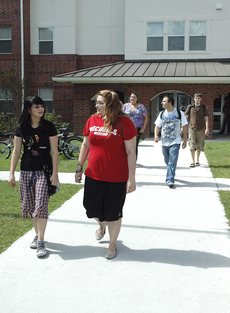University officials estimate the planning for new housing could begin in a year if high occupancy and increased enrollment trends continue on campus.Kim Montague, director of housing and residence life, said housing at Nicholls is at 98 percent occupancy with about 1,400 students living on campus, but the University cannot build new housing until it can show the rooms could be filled. “You’ve got to go a few years without enough room,” Montague said. “The last thing you want to do is build something and not be able to fill it.”
Mike Davis, assistant vice president of administration, said the companies that buy, sell and insure the bonds for building projects on campus like to have a certain level of comfort before committing and often require up to eight years of occupancy records for new housing projects.
Auxiliary services originally used Calecas Hall as an overflow residence hall. “It was strictly renovated just in case a larger number of students applied for housing, but it overflowed and forced us to use Babington,” Davis said. Babington Hall was reopened to house students prior to fall 2008, but Davis said the University could begin planning new housing in a year if Babington stays full.
Davis said any new housing would probably be built where Long and Millet-Zeringue Halls were demolished, and that the University would be exploring new types of housing. Single bedrooms and housing catered toward Greek students are two options Davis said the University might consider. Students can currently choose to live alone on campus, but Davis said private rooms may be reverted back to two-person occupancy if demand for housing increases. “That would be used as further justification to move on new housing,” Davis said.
Though Nicholls housing is approaching maximum occupancy, Montague said the University is six percent below the national average of 26 percent. Montague said the high demand for housing is a result of the three new halls in terms of how they look and the services they provide. “It isn’t all about image, though,” Montague said. “It’s about what these buildings do for students and how we treat them.”
Davis said one reason occupancy at Nicholls has increased is because high school graduates from local communities are attending the University now rather than attending colleges away from their hometowns.
Davis said he agreed with a statement made by University President Stephen Hulbert that Nicholls is rapidly becoming a first choice for students and not a last resort.








